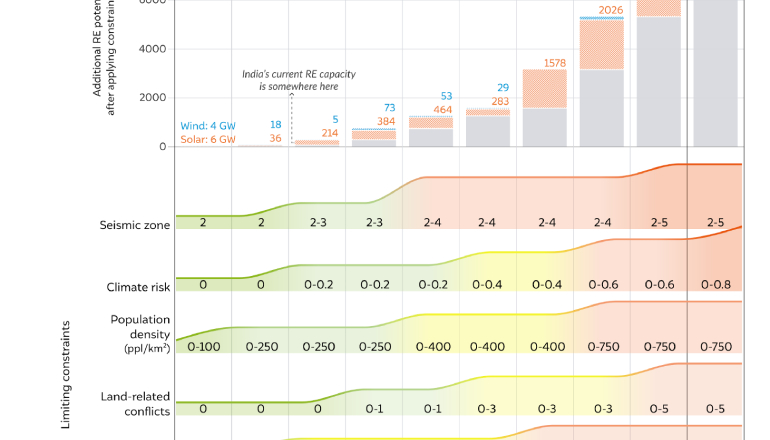CEEW, the independent think tank has raised some eye-opening questions regarding India’s RE target achievements. As per them, scaling India’s renewables beyond 1,500 GW will face considerable land, water, population, and climate challenges.
It is assessed that India has a renewable energy (RE) potential of over 24,000 GW.
India currently has an installed RE capacity of 150 GW, and up to 1,500 GW, the constraints are relatively manageable. But reaching the ~7,000 GW required to achieve net zero emissions by 2070 will require a holistic approach.
Challenges such as land access, climate risks, land conflicts, population density, and other multiple constraints could intensify. This could narrow the runway to reach the net zero target.
These are the findings of a new study by the Council on Energy, Environment, and Water (CEEW). The study is titled, ‘Unlocking India’s RE and Green Hydrogen Potential: An Assessment of Land, Water, and Climate Nexus.’
According to the study, renewable energy including solar, wind, and green hydrogen, is crucial to realise India’s climate goals. However scaling up these technologies will require strategic land use, improved water management, and resilient power grid infrastructure.
Some challenges:
A considerable portion of India’s RE potential is in high-climate-risk and high-land-price areas—only 18 percent of onshore wind potential and 22 percent of solar potential are located in areas with low climate risks and low land prices, when looked at in isolation.
However, the challenges to realizing this potential increase when other constraints such as population density, land conflicts and seasonality of solar power are factored in.
- Population density: Only 29 percent of onshore wind potential and 27 percent of solar potential in areas with a population density lower than 250 people/km2.
- Land conflicts: About 35 percent of onshore wind potential and 41 percent of solar potential located in areas free from historical land conflicts.
However, earthquakes are less of a concern, as 83 percent of onshore wind and 77 percent of solar potential are located in low to moderate seismic zones.
States with high unconstrained RE potential:
As per the CEEW study:
- Rajasthan (6,464 GW), Madhya Pradesh (2,978 GW), Maharashtra (2,409 GW) and Ladakh (625 GW) have significant low-cost solar potential
- Karnataka (293 GW), Gujarat (212 GW), and Maharashtra (184 GW) offer considerable wind potential.
- Odisha and Madhya Pradesh, with high RE potential backed by land banks and infrastructure to evacuate renewable power and manage seasonality, could emerge as key players in meeting India’s renewable energy ambitions in the coming decades.
Green hydrogen push:
CEEW opines that green hydrogen could play a significant role in India’s clean energy transition.
The study estimates that the country could produce around 40 MTPA at a cost lower than $3.5/kg. Water availability and management impact the cost of green hydrogen projects.
This cost is expected to decrease further with advancements in electrolyzer technology and more efficient RE systems.
Low-cost green hydrogen could be produced in western and southern India, with Gujarat leading the production with an estimated potential of 8.8 MTPA at less than $3.5/kg, followed by Karnataka and Maharashtra with 5 MTPA each.
CEEW states:
Dr Arunabha Ghosh, CEO, CEEW, said, “India stands at a pivotal juncture in its energy transition. It has set out to do the near impossible: provide energy access to millions of people, clean up one of the world’s largest energy systems, and become a green industrial powerhouse. While our RE potential is vast, the road to net zero is fraught with challenges. From land conflicts and population density to the unpredictable but undeniable impact of climate change, every step forward will demand resilience and innovation.”
According to her, the scale of the task ahead is monumental. “Yet it is precisely this challenge that will define India’s legacy as a trailblazer for the Global South—a country that charts a low carbon pathway to prosperity against all odds.”
Hemant Mallya, Fellow, CEEW, said, “Land and water are critical resources for scaling up RE and green hydrogen in India. Prevention of desertification and innovative solutions to address land availability, such as agro-voltaics in horticulture and rooftop solar in dense Indian cities, will be essential. Moreover, as RE projects move into areas with higher climate risks, insurance companies could increasingly hesitate to provide coverage. Involving all stakeholders in the early stage of renewable project development and addressing climate risks will help ensure projects are commercially viable in the long run.”
Key takeaways:
The CEEW study recommends a comprehensive approach that includes all stakeholders to ensure that India’s ambitious RE and green hydrogen targets are met sustainably and equitably. The steps include:
- Validating potential using higher-quality data and on-ground assessments is crucial, as current data may not fully reflect real conditions.
- States should establish graded land banks that consider RE quality, water availability, and proximity to infrastructure to ensure rapid project development.
- Evaluating and enhancing grid infrastructure resilience, particularly in regions with high RE seasonality, to support large-scale deployment.
- Revising water management policies to prioritize energy production and assessing the need for surface water storage will be vital to sustaining green hydrogen production and mitigating resource challenges.

